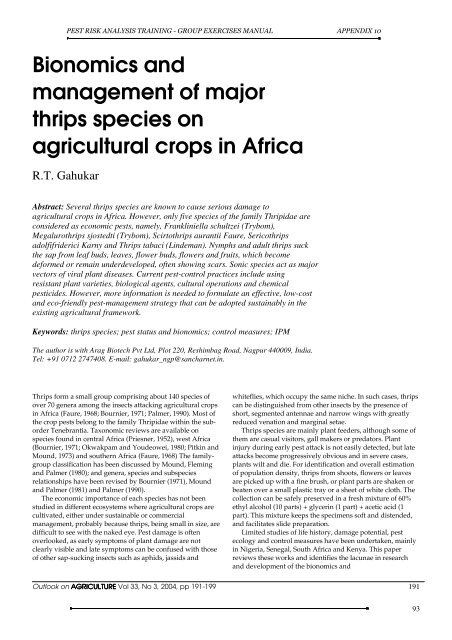PEST RISK ANALYSIS (PRA) TRAINING Group Exercises Manual
PEST RISK ANALYSIS (PRA) TRAINING Group Exercises Manual
PEST RISK ANALYSIS (PRA) TRAINING Group Exercises Manual
You also want an ePaper? Increase the reach of your titles
YUMPU automatically turns print PDFs into web optimized ePapers that Google loves.
<strong>PEST</strong> <strong>RISK</strong> <strong>ANALYSIS</strong> <strong>TRAINING</strong> - GROUP EXERCISES MANUAL APPENDIX 10<br />
Bionomics and<br />
management of major<br />
thrips species on<br />
agricultural crops in Africa<br />
R.T. Gahukar<br />
Abstract: Several thrips species are known to cause serious damage to<br />
agricultural crops in Africa. However, only five species of the family Thripidae are<br />
considered as economic pests, namely, Frankliniella schultzei (Trybom),<br />
Megalurothrips sjostedti (Trybom), Scirtothrips aurantii Faure, Sericothrips<br />
adolfifriderici Karny and Thrips tabaci (Lindeman). Nymphs and adult thrips suck<br />
the sap from leaf buds, leaves, flower buds, flowers and fruits, which become<br />
deformed or remain underdeveloped, often showing scars. Sonic species act as major<br />
vectors of viral plant diseases. Current pest-control practices include using<br />
resistant plant varieties, biological agents, cultural operations and chemical<br />
pesticides. However, more information is needed to formulate an effective, low-cost<br />
and eco-friendly pest-management strategy that can be adopted sustainably in the<br />
existing agricultural framework.<br />
Keywords: thrips species; pest status and bionomics; control measures; IPM<br />
The author is with Arag Biotech Pvt Ltd, Plot 220, Reshimbag Road, Nagpur 440009, India.<br />
Tel: +91 0712 2747408. E-mail: gahukar_ngp@sancharnet.in.<br />
Thrips form a small group comprising about 140 species of<br />
over 70 genera among the insects attacking agricultural crops<br />
in Africa (Faure, 1968; Bournier, 1971; Palmer, 1990). Most of<br />
the crop pests belong to the family Thripidae within the suborder<br />
Tenebrantia. Taxonomic reviews are available on<br />
species found in central Africa (Priesner, 1952), west Africa<br />
(Bournier, 1971; Okwakpam and Youdeowei, 1980; Pitkin and<br />
Mound, 1973) and southern Africa (Faure, 1968) The familygroup<br />
classification has been discussed by Mound, Fleming<br />
and Palmer (1980); and genera, species and subspecies<br />
relationships have been revised by Bournier (1971), Mound<br />
and Palmer (1981) and Palmer (1990).<br />
The economic importance of each species has not been<br />
studied in different ecosystems where agricultural crops are<br />
cultivated, either under sustainable or commercial<br />
management, probably because thrips, being small in size, are<br />
difficult to see with the naked eye. Pest damage is often<br />
overlooked, as early symptoms of plant damage are not<br />
clearly visible and late symptoms can be confused with those<br />
of other sap-sucking insects such as aphids, jassids and<br />
Outlook on AGRICULTURE Vol 33, No 3, 2004, pp 191-199<br />
whiteflies, which occupy the same niche. In such cases, thrips<br />
can be distinguished from other insects by the presence of<br />
short, segmented antennae and narrow wings with greatly<br />
reduced venation and marginal setae.<br />
Thrips species are mainly plant feeders, although some of<br />
them are casual visitors, gall makers or predators. Plant<br />
injury during early pest attack is not easily detected, but late<br />
attacks become progressively obvious and in severe cases,<br />
plants wilt and die. For identification and overall estimation<br />
of population density, thrips from shoots, flowers or leaves<br />
are picked up with a fine brush, or plant parts are shaken or<br />
beaten over a small plastic tray or a sheet of white cloth. The<br />
collection can be safely preserved in a fresh mixture of 60%<br />
ethyl alcohol (10 parts) + glycerin (1 part) + acetic acid (1<br />
part). This mixture keeps the specimens soft and distended,<br />
and facilitates slide preparation.<br />
Limited studies of life history, damage potential, pest<br />
ecology and control measures have been undertaken, mainly<br />
in Nigeria, Senegal, South Africa and Kenya. This paper<br />
reviews these works and identifies the lacunae in research<br />
and development of the bionomics and<br />
191<br />
93













